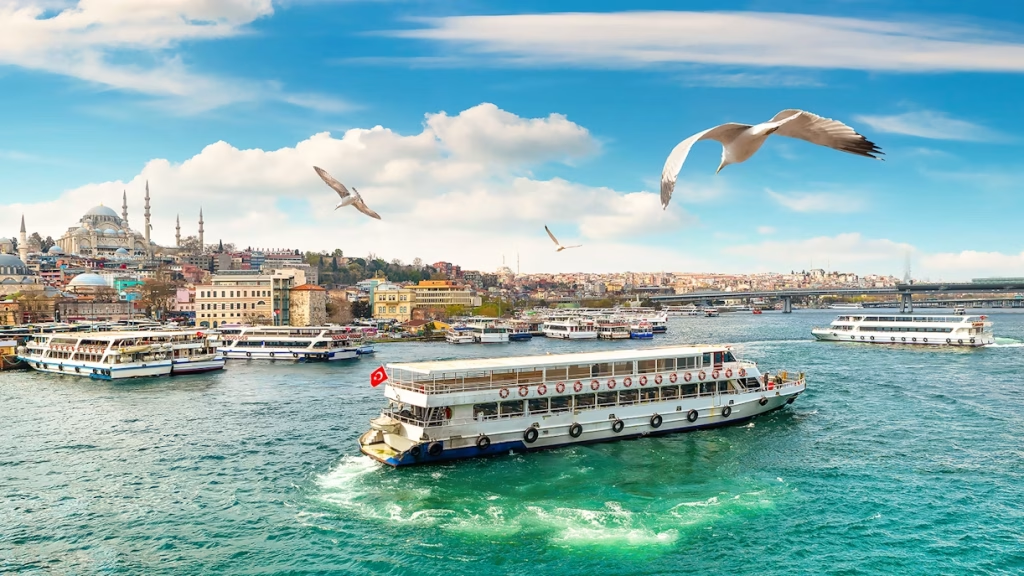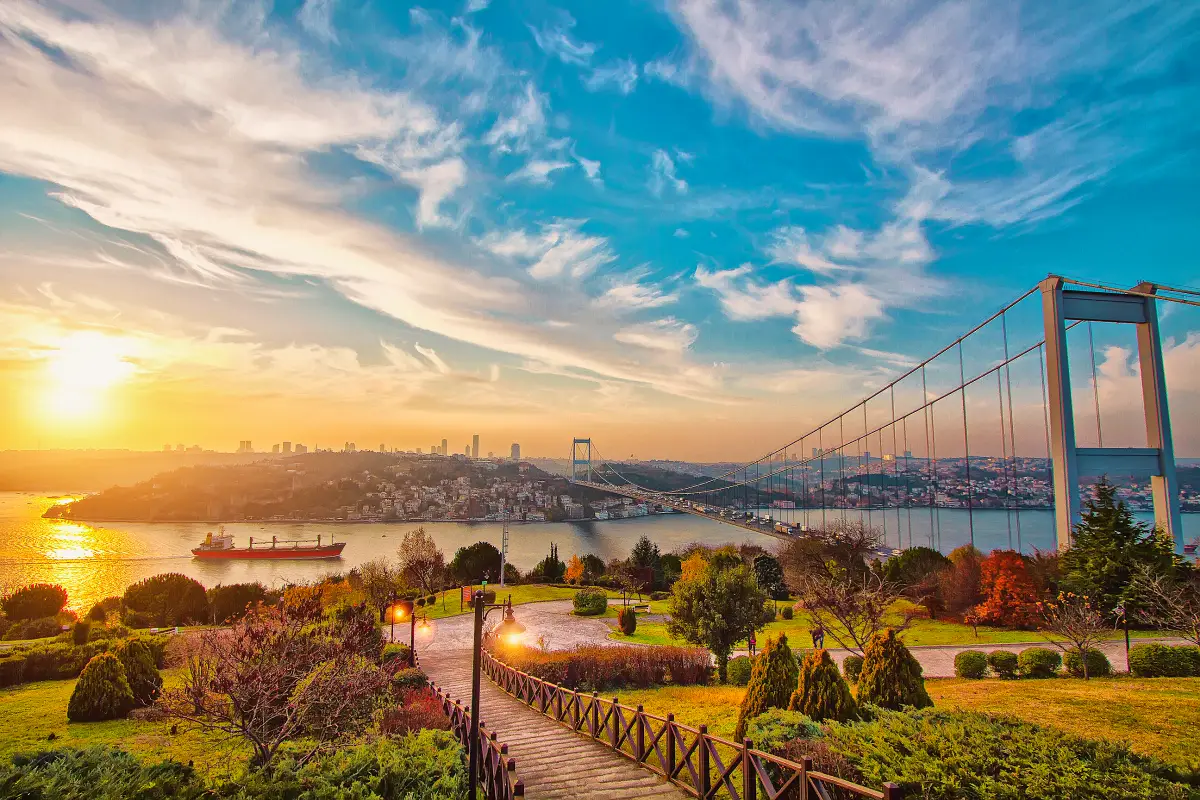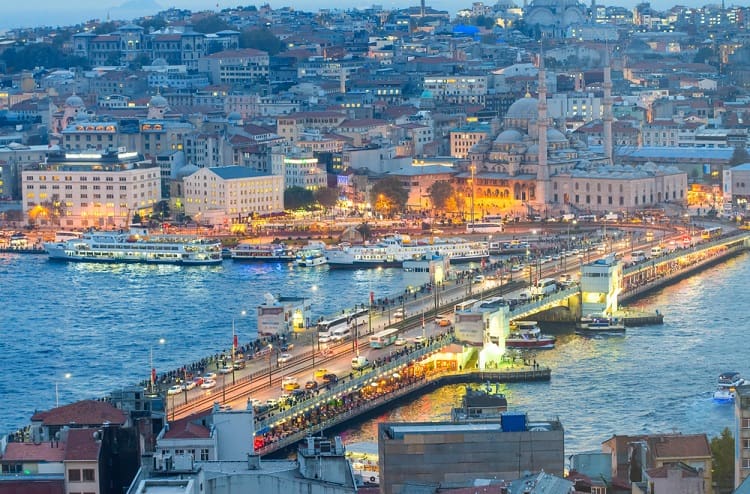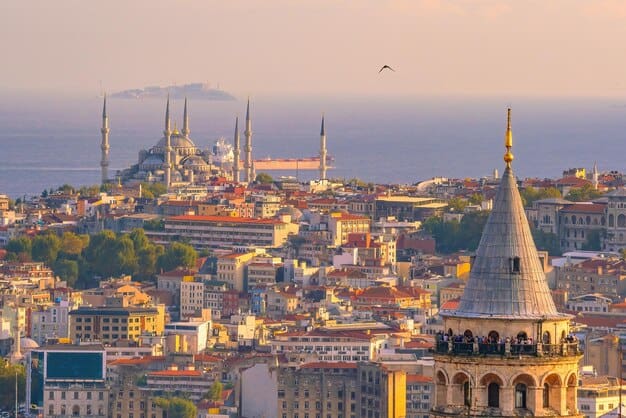The Bosphorus Strait is a stunning natural wonder that slices through Istanbul, Turkey, forming a boundary between the continents of Europe and Asia. This iconic waterway is not just a geographical marvel but also a cultural and historical tapestry that has shaped civilizations for centuries. The Bosphorus Istanbul Turkey has served as a crucial passage for trade and military endeavors, influencing the rise and fall of empires. Join us on a journey through the Bosphorus to uncover its rich history, vibrant culture, and lasting influence on the city of Istanbul.
Table of Contents
The Bosphorus Istanbul Turkey: A Natural Marvel
The Bosphorus Istanbul Turkey, known as “Boğaziçi” in Turkish, is one of the world’s most significant straits. It stretches approximately 30 kilometers (19 miles) in length, with varying widths ranging from 700 to 3,500 meters. This narrow waterway connects the Black Sea to the Sea of Marmara and, ultimately, the Aegean and Mediterranean Seas. The Bosphorus Istanbul Turkey is not only a key maritime route but also a breathtaking natural feature that defines Istanbul’s landscape. As ships glide through its waters, they pass by historical landmarks and scenic vistas that have captivated travelers for centuries.

Geographical Significance
The Bosphorus Istanbul Turkey is more than just a picturesque waterway. Its strategic location has made it a vital trade route for centuries, serving as a gateway between the East and West. This unique position has led to a rich blend of cultures, languages, and traditions that continue to thrive in Istanbul today. The strait’s natural beauty has also attracted settlers and visitors throughout history, making it a focal point for cultural exchange and interaction. Moreover, its geographical significance extends to its role in geopolitical strategies, as control over the Bosphorus means influence over a critical axis of global maritime trade.
Ecological Diversity
The Bosphorus Istanbul Turkey is home to a diverse range of marine life, including dolphins, seals, and various fish species. Its unique ecosystem provides a critical habitat for migratory birds and supports a variety of plant life along its shores. The preservation of this natural environment is essential for maintaining the ecological balance of the region. Conservation efforts are crucial in protecting the Bosphorus from pollution and overfishing, which threaten its biodiversity. The strait’s ecological diversity also offers opportunities for scientific research, contributing to our understanding of marine and avian life in this unique corridor.

Historical Overview of the Bosphorus
The history of the Bosphorus Istanbul Turkey is as deep and intriguing as its waters. Throughout the centuries, this strait has witnessed the rise and fall of empires, serving as a backdrop for countless historical events. From ancient times to the modern era, the Bosphorus has played a pivotal role in shaping the destiny of empires and nations. Its strategic importance has made it a focal point for military campaigns, trade negotiations, and cultural exchanges, leaving behind a legacy that continues to resonate in Istanbul’s vibrant history.
Ancient Civilizations
The Bosphorus Istanbul Turkey has been inhabited since ancient times, with evidence of settlements dating back to the Chalcolithic period. Early civilizations, such as the Thracians and Phrygians, recognized the strategic importance of the Bosphorus and established communities along its shores. These early settlers left behind traces of their presence, including artifacts and ruins that offer glimpses into their lives and cultures. As trade routes developed, the Bosphorus Istanbul Turkey became a crossroads of commerce and culture, linking distant lands and facilitating the exchange of goods and ideas.
Byzantine and Ottoman Empires
The Byzantine Empire, centered in Constantinople (modern-day Istanbul), controlled the Bosphorus for over a millennium. During this time, the strait served as a critical defense line, with fortifications like the Rumeli Fortress guarding its entrance. The Ottomans later conquered Constantinople in 1453, marking a new era of dominance over the Istanbul Bosphorus. The Ottomans constructed impressive architectural landmarks, including the iconic Bosphorus bridges and palaces that still grace the skyline today. These structures not only reflect the empire’s architectural prowess but also symbolize the strategic and cultural significance of the Istanbul Bosphorus in their reign.

Cultural Significance of the Istanbul Bosphorus
The Istanbul Bosphorus is not just a geographical landmark; it is a cultural epicenter that has inspired artists, poets, and musicians for centuries. Its unique blend of Eastern and Western influences creates a vibrant cultural tapestry that is quintessentially Istanbul. The strait’s allure has drawn creative minds from around the world, contributing to a rich legacy of artistic expression. The cultural significance of the Bosphorus is evident in the myriad festivals, performances, and exhibitions that celebrate its beauty and history, making it a living canvas of artistic endeavors.
Literature and Art
The Istanbul Bosphorus has been a muse for many writers and artists, both local and international. From ancient legends to contemporary novels, the strait has inspired countless works that capture its beauty and mystique. Famous authors like Pierre Loti and Orhan Pamuk have penned stories set against the backdrop of the Bosphorus, capturing its essence in their prose. Artists have also depicted the Istanbul Bosphorus in paintings and illustrations, showcasing its dynamic landscapes and vibrant life. The strait’s presence in literature and art highlights its timeless appeal and its role as a source of inspiration for creative minds.
Music and Film
The Istanbul Bosphorus has also made its mark in the world of music and film. Its scenic beauty and historical significance have been featured in numerous films, documentaries, and music videos. The strait’s enchanting allure continues to captivate audiences worldwide, making it a popular setting for artistic endeavors. Musicians and filmmakers often draw on the Bosphorus’s rich history and cultural diversity to create works that resonate with both local and global audiences. The strait’s cinematic presence enhances its reputation as a symbol of Istanbul’s unique blend of tradition and modernity.

Exploring the Istanbul Bosphorus Today
For travelers and locals alike, the Bosphorus offers a wealth of experiences that showcase its cultural and historical richness. From leisurely cruises to bustling markets, there’s something for everyone along this iconic waterway. Visitors can immerse themselves in the vibrant atmosphere of Istanbul, exploring the strait’s many facets through guided tours, cultural events, and culinary adventures. The Bosphorus serves as a living museum, where history and modernity coexist, offering endless opportunities for discovery and exploration.
Bosphorus Cruises
One of the best ways to experience the Bosphorus is by taking a cruise. These tours offer breathtaking views of the city’s skyline, historic landmarks, and natural beauty. Whether you choose a short ferry ride or a full-day excursion, a Bosphorus cruise is an unforgettable experience that provides a unique perspective on Istanbul. Travelers can enjoy panoramic views of the city’s iconic architecture, while knowledgeable guides share stories of the Bosphorus’s rich history and cultural significance. The serene waters of the strait provide a peaceful escape from the city’s bustling streets, allowing visitors to relax and soak in the beauty of Istanbul.

Iconic Landmarks
The Bosphorus is dotted with iconic landmarks that reflect its storied past. Some must-see sites include:
- Dolmabahçe Palace: This opulent palace, located on the European shore, was once the administrative center of the Ottoman Empire. Its grand architecture and lavish interiors offer a glimpse into the opulence of the Ottoman era.
- Bosphorus Bridges: The Bosphorus is spanned by three magnificent suspension bridges, each offering stunning views and connecting the continents of Europe and Asia. These engineering marvels symbolize the unity of Istanbul’s diverse cultural heritage.
- Rumeli Fortress: Built by Sultan Mehmed II, this fortress played a crucial role in the Ottoman conquest of Constantinople. Its imposing walls and towers stand as a testament to the strategic importance of the Bosphorus in the city’s defense.

Local Cuisine and Markets
No visit to the Bosphorus is complete without sampling the local cuisine. The waterfront is lined with restaurants and cafes offering delicious seafood dishes, traditional Turkish mezes, and aromatic teas. Be sure to explore the bustling markets, where you can find everything from spices and textiles to handmade crafts and souvenirs. The culinary scene along the Bosphorus reflects Istanbul’s diverse cultural influences, with flavors and aromas that tantalize the senses. Visitors can enjoy a variety of dining experiences, from casual street food stalls to elegant waterfront restaurants, each offering a taste of Istanbul’s rich culinary heritage.
Preserving the Bosphorus for Future Generations
As a vital cultural and ecological asset, the Bosphorus faces challenges such as pollution, overfishing, and urbanization. Efforts to preserve its natural beauty and historical significance are crucial for ensuring that future generations can continue to enjoy this extraordinary waterway. Conservation initiatives and educational programs play a vital role in raising awareness about the importance of protecting the Bosphorus and its unique ecosystem. By fostering a sense of responsibility and stewardship, these efforts aim to safeguard the strait’s natural and cultural heritage for future generations.
Environmental Conservation
Organizations and local authorities are working to protect the Bosphorus’s unique ecosystem through conservation initiatives and sustainable practices. These efforts aim to reduce pollution, preserve marine life, and maintain the ecological balance of the region. Initiatives include promoting eco-friendly tourism, implementing stricter regulations on maritime traffic, and conducting regular environmental assessments. Collaboration between government agencies, non-profit organizations, and local communities is essential in addressing the environmental challenges facing the Bosphorus and ensuring its preservation for future generations.
Cultural Heritage Preservation
Preserving the Bosphorus’s cultural heritage is equally important. Restoration projects and educational programs help safeguard historical landmarks and promote awareness of the strait’s rich history and cultural significance. Efforts to document and preserve the architectural and archaeological treasures along the Bosphorus contribute to a deeper understanding of its historical legacy. Cultural initiatives, such as exhibitions and workshops, engage local communities and visitors, fostering a sense of pride and connection to the Bosphorus’s storied past.
Conclusion
The Bosphorus is more than just a strait; it’s a living testament to the rich tapestry of history and culture that defines Istanbul. From its ancient civilizations to its modern-day allure, the Bosphorus continues to captivate and inspire. As we explore its wonders, we are reminded of the importance of preserving this unique treasure for generations to come. Whether you’re a history buff, a nature lover, or simply seeking adventure, the Bosphorus offers a journey like no other. Embrace the magic of the Bosphorus and discover the heart of Istanbul, where East meets West in a harmonious blend of culture and history. By cherishing and protecting this extraordinary waterway, we ensure that its beauty and legacy endure, enriching the lives of those who encounter its timeless charm.
FAQs
1. What is the Bosphorus?
The Bosphorus is a natural strait in Istanbul, Turkey, separating Europe and Asia while connecting the Black Sea to the Sea of Marmara.
2. Why is the Bosphorus important?
It holds historical, cultural, and strategic significance, serving as a vital waterway for global trade and showcasing Istanbul’s rich heritage.
3. What are the top attractions along the Bosphorus?
Key landmarks include Dolmabahçe Palace, Topkapi Palace, Ortaköy Mosque, Rumeli Fortress, and the Bosphorus Bridges.
4. How can I explore the Bosphorus?
You can take public ferries, private yacht tours, or dinner cruises to enjoy the scenic views and historic sites.
5. When is the best time to visit the Bosphorus?
Spring (April–June) and autumn (September–November) offer pleasant weather and stunning views.
6. Can I walk along the Bosphorus?
Yes, there are scenic walking routes, including Bebek, Arnavutköy, and Emirgan, featuring cafés, parks, and historic mansions.
7. Are there restaurants with Bosphorus views?
Yes, many waterfront restaurants in Ortaköy, Bebek, and Kuruçeşme offer delicious Turkish cuisine with stunning Bosphorus views.
8. What is the Bosphorus Bridge?
The 15 July Martyrs Bridge is the first bridge connecting Europe and Asia, offering spectacular views, especially at night.
9. Are there boat tours at night?
Yes, many cruises offer evening tours with dinner, music, and illuminated views of Istanbul’s skyline.
10. Is the Bosphorus safe for visitors?
Yes, the Bosphorus is safe for tourists, with well-regulated ferry services and guided tours ensuring a great experience.
11. How long does a Bosphorus cruise take?
Cruises vary in duration, from short 1-hour tours to full-day excursions, including stops at historical sites and charming waterfront villages.
12. Can I swim in the Bosphorus?
Swimming in the Bosphorus is not recommended due to strong currents and busy maritime traffic, but nearby beaches along the Black Sea coast are great alternatives.
13. What is the best way to photograph the Bosphorus?
For stunning photos, visit Ortaköy, Rumeli Fortress, or the Galata Tower, or take a sunset cruise for magical skyline shots.
14. Are there historical palaces along the Bosphorus?
Yes, the Dolmabahçe Palace, Beylerbeyi Palace, and Küçüksu Pavilion are some of the Ottoman-era palaces along the Bosphorus.
15. Do Bosphorus cruises include food?
Many cruises offer dining options, from simple snacks to full-course meals on luxury dinner cruises with live entertainment.
16. How much does a Bosphorus tour cost?
Prices vary based on the type of tour. Public ferry rides are budget-friendly, while private yacht tours and dinner cruises can be more expensive.
17. Are there public transport options for exploring the Bosphorus?
Yes, Istanbul’s public ferries (Şehir Hatları) provide an affordable way to explore the Bosphorus with scenic views.
18. What are the best neighborhoods along the Bosphorus?
Popular areas include Ortaköy, Bebek, Arnavutköy, Üsküdar, and Emirgan, each offering unique charm, cafes, and historical sites.
19. Is it possible to cross the Bosphorus on foot?
No pedestrian access is available on the main Bosphorus bridges, but you can use Marmaray (underground rail), ferries, or road transport.
20. Are there any annual events on the Bosphorus?
Yes, notable events include the Bosphorus Cross-Continental Swim, Bosphorus Boat Races, and fireworks on New Year’s Eve.
21. Can I see dolphins in the Bosphorus?
Yes, dolphins are occasionally spotted in the Bosphorus, especially during early morning hours and in less crowded areas.
22. Are there any historical forts along the Bosphorus?
Yes, the Rumeli Fortress and Anadolu Fortress, both built during the Ottoman era, are significant historical sites with great views.
23. What is the difference between the first, second, and third Bosphorus bridges?
- 15 July Martyrs Bridge (First Bridge) – The oldest and most central.
- Fatih Sultan Mehmet Bridge (Second Bridge) – Located further north.
- Yavuz Sultan Selim Bridge (Third Bridge) – The newest and largest, mainly for heavy traffic.
24. Can I visit the Princes’ Islands from the Bosphorus?
No, the Princes’ Islands are located in the Sea of Marmara, but you can take ferries from Eminönü or Kadıköy to reach them.
25. What are the best Bosphorus parks for relaxation?
Emirgan Park, Fethi Paşa Grove, Yıldız Park, and Bebek Park offer stunning views, lush greenery, and a peaceful atmosphere.
26. Are there any traditional markets near the Bosphorus?
Yes, Beşiktaş Fish Market, Arnavutköy Street Market, and Üsküdar’s Spice Shops offer local flavors and authentic Turkish products.
27. Can I take a ferry from Europe to Asia?
Yes, public ferries connect Eminönü, Karaköy, and Beşiktaş (Europe) with Üsküdar and Kadıköy (Asia), providing a scenic and affordable ride.
28. What is the best way to enjoy the Bosphorus at night?
A dinner cruise, a rooftop restaurant, or a walk along Ortaköy and Bebek are great ways to experience the Bosphorus at night.
29. Do I need to book a Bosphorus tour in advance?
For public ferries, no booking is required, but for private yacht tours and dinner cruises, it’s best to book in advance.
30. What is the local cuisine I should try along the Bosphorus?
Try fresh seafood, Balık Ekmek (fish sandwich), Meze, Simit, and Turkish tea at the waterfront restaurants and street vendors.



